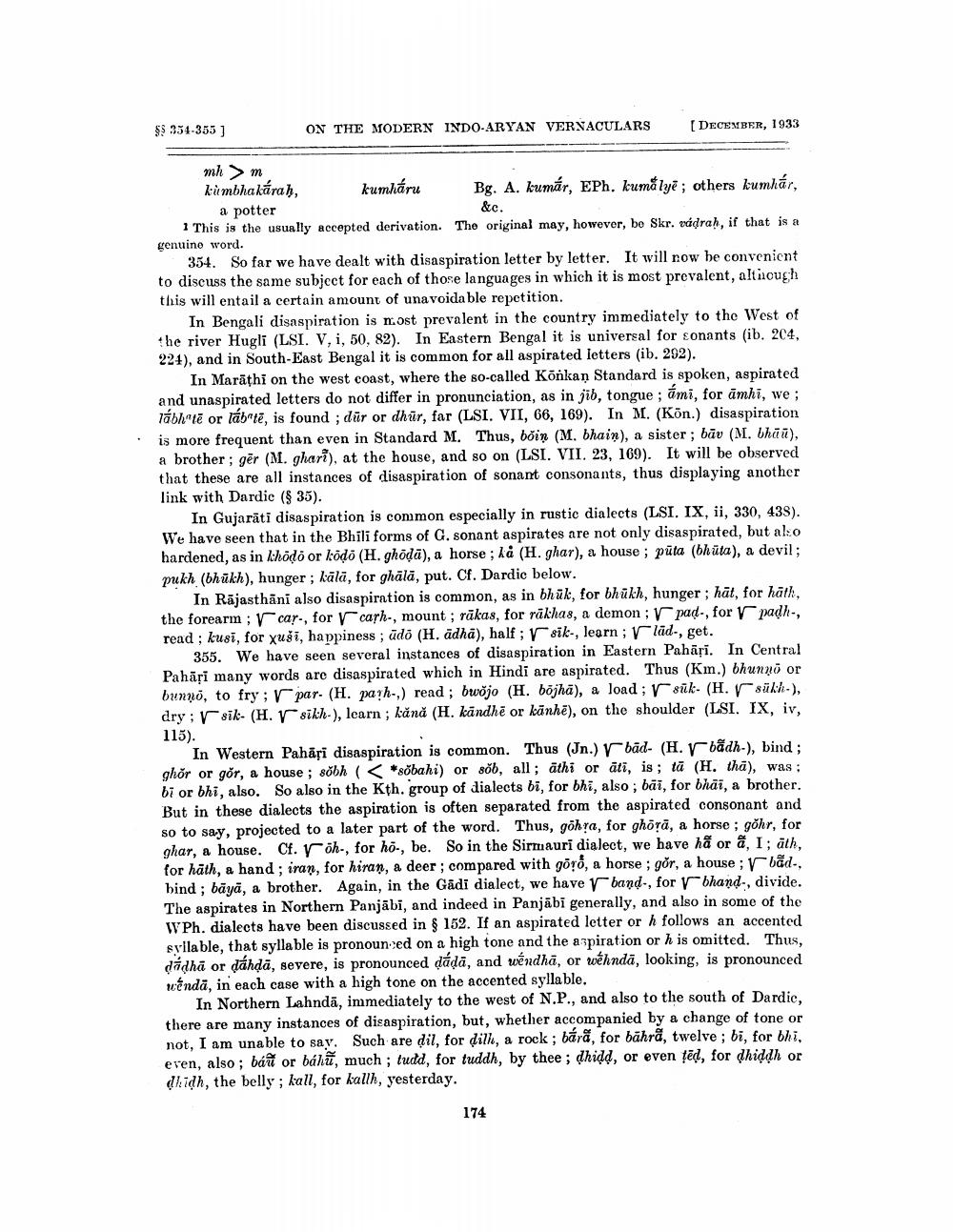________________
$$ 351-355 )
ON THE MODERN INDO-ARYAN VERNACULARS
[ DECEMBER, 1933
kumháru
Be
&c.
mh>m kumbhakárah,
Bg. A. kumár, EPh. kumălye ; others kumhár, a potter 1 This is the usually accepted derivation. The original may, however, be Skr. vádraḥ, if that is a genuino word.
354. So far we have dealt with disaspiration letter by letter. It will now be convenient to discuss the same subject for each of those languages in which it is most prevalent, altiough this will entail a certain amount of unavoidable repetition.
In Bengali disaspiration is most prevalent in the country immediately to the West of the river Hugli (LSI. V, i, 50, 82). In Eastern Bengal it is universal for conants (ib. 204, 224), and in South-East Bengal it is common for all aspirated letters (ib. 292).
In Marathi on the west coast, where the so-called Konkan Standard is spoken, aspirated and unaspirated letters do not differ in pronunciation, as in jib, tongue; ámi, for āmhi, we ; táblatē or lábate, is found ; dūr or dhūr, far (LSI. VII, 66, 169). In M. (Kön.) disaspiration is more frequent than even in Standard M. Thus, bõin (M. bhain), a sister; būv (M. bhāü), a brother; gēr (M. ghari), at the house, and so on (LSI. VII. 23, 169). It will be observed that these are all instances of disaspiration of sonant consonants, thus displaying another link with Dardic ($ 35).
In Gujarāti disaspiration is common especially in rustic dialects (LSI. IX, ii, 330, 43S). We have seen that in the Bhili forms of C. sonant aspirates are not only disaspirated, but also hardened, as in Ichôdo or kõdo (H. ghodā), a horse; kå (H. ghar), a house ; pūta (bhūta), a devil; pukh (bhūkh), hunger; kālā, for ghāla, put. Cf. Dardie below.
In Rājasthāni also disaspiration is common, as in bhūk, for bhūkh, hunger ; hāt, for hath, the forearm ; car., for cash-, mount; rākas, for rākhas, a demon; r pad-, for v padh, read; kusi, for xuši, happiness; ūdo (H. adha), half;rsik-, learn ; r lūd., get.
355. We have seen several instances of disaspiration in Eastern Pahāri. In Central Pahāri many words are disaspirated which in Hindi are aspirated. Thus (Km.) bhunno or bunno, to fry; par(H. path-,) read; bwojo (H. bojha), a load ; r sūk- (H. r sūkh-), dry; V sik- (H. V sikh-), learn; kănă (H. kāndhē or kānhē), on the shoulder (LSI. IX, iv,
115).
In Western Pahāri disaspiration is common. Thus (Jn.) r bād- (H. r badh.), bind : ghor or gør, a house ; sõbh (< *sõbahi) or sõb, all; āthi or āti, is; tä (H. tha), was : bi or bhi, also. So also in the Kth. group of dialects bi, for bhi, also, bãi, for bhai, a brother. But in these dialects the aspiration is often separated from the aspirated consonant and so to say, projected to a later part of the word. Thus, göhra, for ghorā, a horse ; gõhr, for ghar, a house. Cf. roh-, for hő-, be. So in the Sirmauri dialect, we have hã or a, I; äth, for häth, a hand; iran, for hiran, a deer; compared with goro, a horse ; gõr, a house ; bãd., hind; bāyā, a brother. Again, in the Gadi dialect, we have r band-, for r bhand., divide. The aspirates in Northern Panjabi, and indeed in Panjābi generally, and also in some of the WPh. dialects have been discussed in § 152. If an aspirated letter or h follows an accented syilable, that syllable is pronoun-ed on a high tone and the aspiration or h is omitted. Thus, dádhā or dándā, severe, is pronounced dáda, and wéndhā, or wéhndā, looking, is pronounced wenda, in each case with a high tone on the accented syllable.
In Northern Lahndā, immediately to the west of N.P., and also to the south of Dardic. there are many instances of disaspiration, but, whether accompanied by a change of tone or not, I am unable to say. Such are dil, for dill, a rock; bära, for bāhra, twelve ; bi, for bhi, even. also : báūt or bálū, much; tudd, for tuddh, by thee; dhidd, or even téd, for dhiddh or dhidh, the belly; kall, for kalih, yesterday.
174




